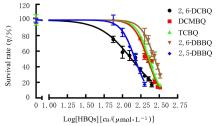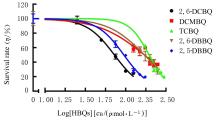吉林大学学报(医学版) ›› 2023, Vol. 49 ›› Issue (3): 640-646.doi: 10.13481/j.1671-587X.20230312
水消毒副产物卤代苯醌的结构与毒性分析
- 1.吉林大学公共卫生学院卫生毒理学教研室,吉林 长春 130021
2.吉林国际旅行卫生保健中心长春海关口岸门诊部,吉林 长春 130062
3.广西壮族自治区河池市疾病预防控制中心,广西 河池 547000
Analysis on structure and toxicity of water disinfection by-products halobenzoquinones
Haiying DU1( ),Yongli JIANG2,Yingguan WEI1,3,Jinhua LI1,Rifeng LU1
),Yongli JIANG2,Yingguan WEI1,3,Jinhua LI1,Rifeng LU1
- 1.Department of Health Toxicology,School of Public Health,Jilin University,Changchun 130021,China
2.Changchun Customs Port Outpatient Department,Jilin International Travel Health Care Center,Changchun 130062,China
3.Hechi Center for Disease Control and Prevention,Guangxi Zhuang Autonomous Region,Hechi 547000,China
摘要:
目的 分析卤代苯醌(HBQs)对人肝癌HepG2细胞的半数抑制浓度(IC50)与结构参数间的定量构效关系,探讨可能影响HBQs细胞毒性的结构参数。 方法 体外培养HepG2细胞,采用不同浓度HBQs溶液作用细胞,同时设空白对照组[10%胎牛血清(FBS)+DMEM培养基]和阴性对照组[10% FBS+DMEM培养基+1.33% 甲醇(MeOH)]。MTS法和中性红摄取试验(NRU)法确定HBQs的作用浓度,采用MTS法和NRU法检测各组细胞存活率并计算HBQs对人肝癌HepG2细胞的IC50。采用量子化学计算模块MOPAC计算每种HBQs的结构参数。采用单因素线性回归分析方法,根据HBQs的IC50和HBQs结构参数构建定量结构-毒性关系(QSTR)模型。 结果 MTS法检测2,6-二氯-1,4-苯醌(2,6-DCBQ)的作用浓度为75、100、125、150、175、200、225和250 μmol·L-1,2,6-二氯-3-甲基-1,4-苯醌(DCMBQ)的作用浓度为175、200、225、250、275、300和325 μmol·L-1,2,3,6-三氯-1,4-苯醌(TCBQ)的作用浓度为200、225、250、275、300和325 μmol·L-1,2,5-二溴-1,4-苯醌(2,5-DBBQ)的作用浓度为75、100、125、150、175和200 μmol·L-1,2,6-二溴-1,4-苯醌(2,6-DBBQ)的作用浓度为200、225、250、275、300和325 μmol·L-1;NRU法检测,2,6-DCBQ的作用浓度为25、50、75、100和125 μmol·L-1,DCMBQ的作用浓度为125、150、175、200、225和250 μmol·L-1,TCBQ的作用浓度为175、200、225、250、275和300 μmol·L-1,2,5-DBBQ的作用浓度为75、100、125、150和175 μmol·L-1,2,6-DBBQ的作用浓度为125、150、175、200、225和250 μmol·L-1。各组HepG2 细胞存活率随HBQs浓度的升高明显降低,呈现明显剂量-反应关系。MTS法检测HBQs对HepG2细胞毒性作用为2,6-DCBQ>2,5-DBBQ>DCMBQ>TCBQ>2,6-DBBQ;NRU法检测HBQs对HepG2细胞毒性作用为2,6-DCBQ>2,5-DBBQ>DCMBQ>2,6-DBBQ>TCBQ。单因素多元线性回归分析,MTS法和NRU法检测HBQs 的IC50与HBQs结构参数间相关性分析比较差异均无统计学意义(P>0.05)。 结论 卤代原子的取代位置、种类和数量可影响HBQs的毒性作用,且呈现卤素取代个数越多其毒性越小的趋势。
中图分类号:
- R114




